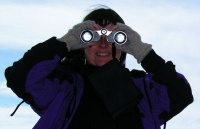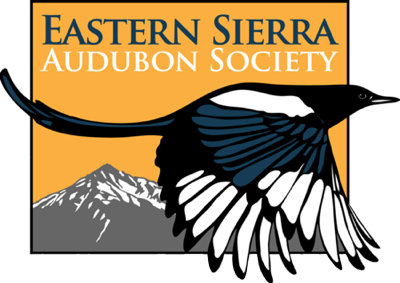
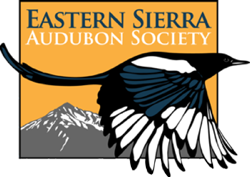
Sierra Wave
Newsletter
Volume 33, Number 2
November-December, 2014
Sierra Wave Newsletter
Volume 33, Number 2
Novembr-December, 2014
Contents
- Events:
- Features:
- Reports:
- Business
Events
Holiday Candlelight Dinner & Program, December 10, 6pm
The December 10th meeting is also our annual Holiday potluck candlelight dinner, held at 6pm in the dining room of the White Mountain Research Center.
Do plan to attend as it is a fun event, and bring a friend or neighbor! Every participant should bring a dish (entrée, salad, or dessert to serve at least 6 people, and contribute either juice, soft drinks, wine or beer to the beverage table.) We often run out of food, so we would appreciate contributions of larger portions so there will be sufficient food for everyone. Please bring your own place setting. Audubon will provide coffee, tea, juice, and a touch of wine prior to the dinner. Also, we encourage you to bring more main dishes and salads this year than desserts, as last year we ran out of main dishes, but had leftover desserts. Everyone was still happy and well-fed, though! Arrive by 5:45 to have time to socialize before 6pm when we'll begin our dinner.
The dinner will be followed by a program at 7pm:
Dancing Birds in the Sagebrush Sea of the Eastern Sierra,
the Bi-State Distinct Population of Greater Sage-Grouse
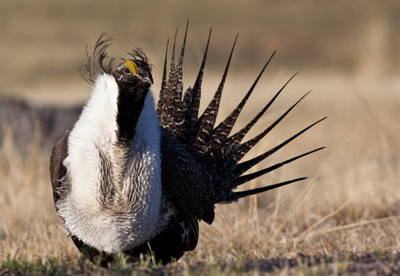
Greater Sage-Grouse Dancing up a Storm
Join us at White Mountain Research Center, Owens Valley Station, on Wednesday December 10th, 2014, for our annual holiday candle-light potluck dinner (6pm), followed by a special presentation by Sherri Lisius, BLM Wildlife Biologist working with our local Greater Sage-Grouse populations (7pm).
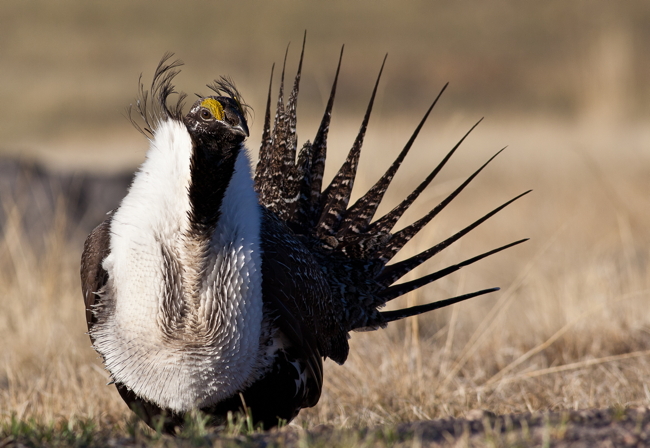
Greater Sage-Grouse caught in the act
Dancing Birds in the Sagebrush Sea of the Eastern Sierra
(the Bi-State Distinct Population of Greater Sage-Grouse)
This talk will discuss the Bi-State Distinct Population Segment of Greater Sage-Grouse, recently proposed as Threatened under the Endangered Species Act. The talk will include a discussion of the life cycle of the bird, an update on the status of the species, and an overview of actions the Local Area Working Group are doing to conserve the grouse and its habitat.
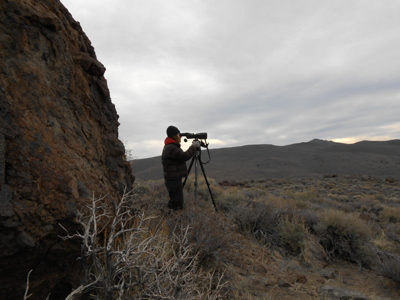
Sherri Lisius at work
Sherri Lisius is currently the wildlife biologist for the BLM in Bishop, California. She has captured, counted and monitored Sage-Grouse in the Bi-State DPS since 2010. Sherri has worked in the Sierra Nevada on and off since 1990. Her work has included; bear management, amphibian surveys, backcountry ranger and wildlife biologist. Sherri received a bachelor of science in Wildlife Management from Humboldt State University in 2002.
For more information contact Jenny Richardson (email jennyn63@gmail.com or call 760-920-8541). Also, check back to the programs page for updates to the list of future speakers. Everyone is welcome to attend all programs!
Back to Top
Upcoming ESAS Field Trips and Other Events
Bishop COSA, Bird Walk and Census, Saturday, November 8, 8:30am and Sunday, December 14, 1:30pm
[Ed. Note: COSA walks are held on the second Saturday of every month, unless otherwise indicated]
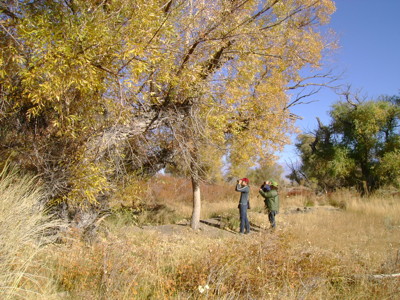
Autumn Birding in the COSA
The November Conservation Open Space Area (COSA) walk will be the second Saturday of the month at 8:30am, as usual. The December COSA walk, however, will coincide with the Christmas Bird Count on Sunday, December 14th. We will meet at 1:30pm at the back of the BLM/USFS Offices at the COSA trailhead, and participants will have a chance to find birds with the talented birders that lead the Christmas Bird Count!
All are welcome - these walks are for birders of ALL LEVELS, beginners included! We will bring extra binoculars and field guides to share.
The Conservation Open Space Area is being developed for wildlife and the community by the Bishop Paiute Tribe. We are keeping species lists and observing behavior as well as identifying birds, for the purpose of creating bird lists for the site. For more information, read this article on the COSA in the March-April 2013 Sierra Wave newsletter. There have been surprises every month so far - come find out what new birds we'll see next time!
Please meet for the Saturday, November 8th walk at 8:30am at the BLM/Forest Service Building on West Line Street in Bishop.
For the Sunday, December 14th COSA walk, please meet at 1:30pm at the same place, the BLM/Forest Service Building on West Line Street in Bishop.
Contact Hillary Behr for more information, or if you are interested in leading a future monthly walk: hillarybehr@yahoo.com.
Back to Top
NEW!! Antelope Valley Sunday Birding Begins December 7th, 9am
Leader: Elena Espinosa
Local Coleville resident and seasoned birder Elena Espinosa will be leading weekly bird walks in the Antelope Valley area on Sundays, beginning December 7th. We will look for birds along the shoreline of Topaz Lake and explore riparian habitat and open fields for permanent and migrant species such as Loons, Mergansers, Golden Eagles and Ruby-crowned Kinglets. The walks should last 2-3 hours.
Meet: Parking lot of Walker Country Store (107700 Hwy 395) at 9am on Sundays, beginning December 7, 2014. Bathrooms are in the store along with hot/cold drinks and snacks.
Bring: Binoculars and spotting scopes, field guides, snacks and water. Wear warm and layered clothing.
Contact Elena for more information: 928-300-8088 or espinosa2015@gmail.com.
Back to Top
Christmas Bird Counts in the Eastern Sierra
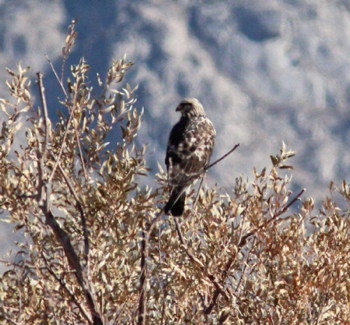
Rough-legged Hawk - photo by Debby Parker
Bishop Christmas Bird Count
Sunday, December 14
The 33rd annual Bishop Christmas Bird Count is Sunday, December 14, 2014. All skill levels are invited to participate. Please RSVP as soon as possible if you can help and indicate if you prefer a specific area or team-mate. I will assign areas in advance to give you a chance to scout. If you'd prefer to be a feeder-watcher, as opposed to covering an area, please let me know.
A few of the exciting birds from 2013 were Barrow's Goldeneye - new to the Bishop count, Pink-sided Junco, Black-crowned Night-Heron, Williamson's Sapsucker, Greater Yellowlegs, and a Rough-legged Hawk. See the summary of 2013 CBC results here.
RSVP to: Chris Howard, Bishop CBC compiler at chris93514@gmail.com or 760-920-2845 (cell)
Mono Basin Christmas Bird Count - Thursday, December 18:
Contact: Kristie Nelson, Phone:
760-709-1670 (Note Date Change)
Mammoth Lakes Christmas Bird Count - Saturday, December 20:
Contact: Bill Taylor, Phone: 760-709-6964
Check our CBC page for other counts in our area, which will be posted as the information becomes available.
Back to Top
Other Organizations' Events of Interest
The Next Steppe: Sage-Grouse and Rangeland Wildfire in the Great Basin
November 5-7, Boise, Idaho - or attend virtually via Live Stream right to your computer at home or work!
This conference is being live-streamed so even if you can't run off to Idaho in the next day or two, you can attend virtually if you are interested. Below is information from the conference website: www.nifc.gov/fireandsagegrouse/
The Next Steppe, is a conference about rangeland fire, sage-steppe habitat and sage-grouse. More than a gathering to share information, this conference aims to end with a clear path forward and the foundation of a comprehensive strategy that combines the best scientific knowledge and operational practices to improve and restore sagebrush ecosystems.
It's no secret that sagebrush-steppe habitat in the Great Basin is in trouble. There are a number of contributing factors but chief among them are wildfire and invasive species. Over time, we have seen a repeating cycle of fire followed by the spread of dominating and highly flammable invasive annual grass which leads to more fire, greater spread of invasives over an ever larger area, more fire and so on. The adverse effects on the vegetative landscape have been cumulative and severe.
Neither science nor operations alone can break this cycle. Rather, it will take an operational response rooted in sound science. Together, science and operations provide a foundation for and the essence of a strategy to interrupt the fire-invasives cycle and begin to restore critical sage-steppe ecosystems and habitat.
Read More on their website, and learn how to attend the conference online.
Back to Top
International Sage-Grouse Forum
to be Live Streamed in Lee Vining November 13-14
This opportunity to learn about Sage-Grouse and volunteer opportunities is FREE
On Thursday November 13 and Friday November 14, the International Sage-Grouse Forum being held in Salt Lake City, Utah will be live streamed at the Lee Vining Community Center located at 296 Mattly Ave, in Lee Vining, CA. The event will begin at 7am each day and is free and open to the public.
The sage-grouse forum is focusing on “Conservation through Science, Management, and Local Community Involvement.” “We encourage anyone interested in the conservation of our sagebrush communities here on the east side to attend this free educational forum,” said Jeff Hunter of the Bodie Hills Conservation Partnership. “That includes students, ranchers, retirees, representatives from conservation groups, land management agencies and local government,” Hunter added.
The forum takes place just days before the Humboldt-Toiyabe National Forest and the Nevada Department of Wildlife (NDOW) are planning to host a major re-vegetation project in the footprint of 2013’s Spring Peak Fire which burned more than 14,000 acres of sage-grouse and mule deer habitat in California and Nevada. That project hopes to plant 24,000 sagebrush & bitterbrush seedlings in the burn area over the weekend of Nov 14-16. For more details or to sign up as a volunteer for the project, please visit NDOW’s website.
The forum will feature a session on sage-grouse conservation efforts focused on the Bi-State distinct population segment (DPS) of Greater Sage-Grouse, which are found locally in Mono & Inyo County, and adjacent Mineral County, Nevada. That session will take place on Nov 13 at 9:30am. To view the full conference agenda, please visit http://sage-grouseforum.org/Agenda.cfm
Coffee, water and snacks will be provided free of charge. If you would like to attend all or part of the program, please email info@bodiehills.org or call Jeff at 760-935-3960.
Back to Top
Owens Lake Bird Festival - Save the Date! April 25, 2015
Friends of the Inyo is planning the 1st annual Owens Lake Bird Festival for April 25, 2015. Audubon will be involved in helping with this event at the lake, which is an Audubon Important Bird Area (IBA). The event is still in the planning stages, so there is plenty of room for volunteers. If you are interested in volunteering in any capacity, please contact event coordinator Ursula Esser at Friends of the Inyo (see contact information below), or for volunteering to lead a field trip, contact Michael Prather (760-876-5807), and/or Barbara Kelley who will also be coordinating with Friends of the Inyo on the event. Or email all three to help with coordination of volunteers. Below is the information from Friends of the Inyo (from their website) on this exciting event:
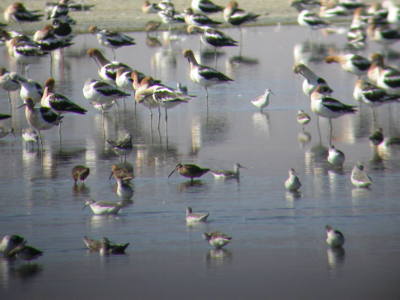
Mixed Shorebird Species at Owens Lake
Please join us for our 1st Annual Owens Lake Bird Festival on April 25th, 2015, and an Opening Reception on Friday, April 24th at the Lone Pine Film History Museum.
The Festival promises to offer a variety of field trips and showcase the unique habitat and significance of Owens Lake at the height of spring migration.
Designated as an Important Bird Area (IBA) by the National Audubon Society, Owens Lake offers world-class wildlife viewing in the southern Owens Valley.
Concomitant with Festival, we are sponsoring a photography exhibit by Robin Black at the Interagency Visitor Center. The exhibit entitled "Second Chance: The Owens Lake Project" will run from March 1- April 30, 2015, with an exhibit reception and closing event for our Festival day on Saturday, April 25th.
Our Festival partners include Eastern Sierra Audubon, California Audubon, Eastern California Museum, Eastern Sierra Interpretive Association, Interagency Visitor Center, Los Angeles Department of Water and Power and the Lone Pine Chamber of Commerce.
Save the Date and reserve your Lone Pine Motel room now for the weekend of April 24-26th, 2015!
For more information, please email Ursula (info@friendsoftheinyo.org) or call 760-873-6500.
Registration: Online registration and field trip sign-ups will open in mid-February 2015, exact date to be determined. More information available soon on the event's webpage.
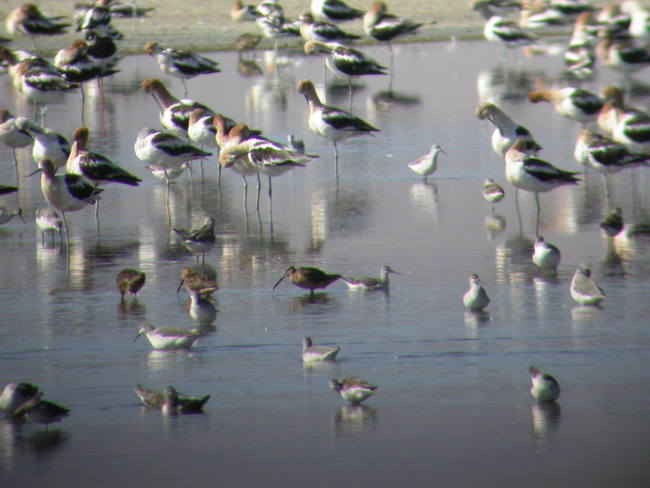
Mixed Shorebird Species at Owens Lake
Back to Top
Features
President’s Message
“For conservation to succeed in this country, you need to
occupy the center and work with people on the land
whose interests are affected by your goals” — Jeff Eisenberg
“For conservation to succeed in this country, you need to
occupy the center and work with people on the land
whose interests are affected by your goals”
— Jeff Eisenberg
There were fifteen or so people gathered in a high meadow on a classic Eastern Sierra fall morning – Crisp and clear, with bright sunlight but a hint of chill in the morning; a good day to do physical work. That was a good thing because that was what we were there to do. This beautiful land, newly blessed with the assurances of a conservation easement, has value to Sage-Grouse. We were there to work on making the fences less dangerous to the birds and other wildlife. By gathering to do this work, we make it just a little easier for the owner/rancher to be a good steward to the grouse. If I ask you to do something, I should be willing to help out. So there I was along with other people associated with ESAS, the Eastern Sierra Land Trust, U. S. Fish and Wildlife Service, California Fish and Wildlife and BLM. To me, this was a classic ESAS activity: doing something proactive and positive for bird habitat, doing work on the ground and working with partners, each of us leveraging the benefit of our individual efforts. It pleased me to have the chance to participate as a representative of our chapter.
“Who speaks for the mountains?” asked William O. Douglas. As far as our birds are concerned, part of the answer is Eastern Sierra Audubon. We have spoken up on behalf of the habitat needs of Eastern Sierra birds for more than twenty five years. The Audubon Mission Statement directs us, among other things, “to conserve and enhance natural habitats,” and we take that seriously. There are many issues and processes which arise in our part of the world and, theoretically, all of these have some degree of potential to impact habitats. Our organization gets a great many requests to become part of some effort or speak out on some issue or another. Realistically, we cannot accept all offers; we lack the resources, in terms of financing, expertise, and human time and energy to do so.
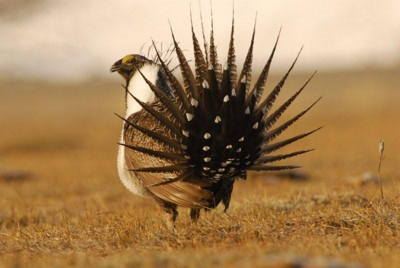
Greater Sage-Grouse, photo by Donna Willey
Eastern Sierra Land Trust and partners, including Audubon, work together to tag fences to help protect the Distinct Population Segment of Bi-State Greater Sage-Grouse habitat on Sinnamon Meadows.
(Click the icon on the lower right when playing video to view full-screen)
How has the chapter made its choices about involvement? The board has employed several criteria in making sometimes difficult choices. We look for a direct involvement with bird populations. Owens Lake was designated as an Important Bird Area and it seemed natural that the Audubon Chapter had an obligation to act when it was perceived that it was in jeopardy. Similarly, the Sage-Grouse has been proposed for listing as endangered and we have significant numbers of these birds within our chapter’s boundaries. Secondly, we had to have chapter and board members who were interested in these issues and willing and able to devote time to them. Lastly, we look for situations in which we can work in partnership with other groups.
Sometimes, these works are played out in a formal way. We may have initiated the Owens Lake conversation, but we quickly sought out and obtained the participation of more than thirty other groups, agencies, tribes, public and private entities, and individuals. We have been able to participate, in a very subordinate way, in the Bi-state Sage-Grouse Initiative, which led us to obtain a California Audubon grant to support Sage-Grouse habitat stewardship and develop, teach and publicize viewing mechanisms and protocols which protect the birds from the over-zealous admiration of people. We are fortunate to be able to work on this effort with the Eastern Sierra Land Trust, LADWP, California Fish and Wildlife, BLM and the Forest Service.
More often, our involvement is informal, made possible by the fact that many of our chapter and board members are active with other organizations. Information is exchanged through these networks, questions are asked and answered and, while ESAS may not have taken an “official position”, we try to help inform those who have done so.
The bottom line is that we will have to pick and choose among many possible matters. Personally, I do not want to become “one of the usual suspects.” It is my hope that we will restrict ourselves to those issues in which our activities can be meaningful and helpful to the resolution of problems. As an organization, the Audubon Society enjoys a reputation for positive contribution, proactive action, and
being resolution-oriented. Hopefully, our chapter fits into this picture. Whatever we do, we should strive mightily to do it well. Our board of directors takes seriously the position of Audubon within the broad community of people who are interested in the amazing landscapes and habitats of Mono and Inyo counties. We invite people to bring their concerns to the chapter but caution that we do not automatically become involved in all things “environmental.” We are all in this together: everyone, not just those with which we are thought to be predisposed to agree. There are so many opportunities to do good work here and we would welcome, with wide-open arms, people who would like to pitch in. Many thanks to the people who worked in the meadow; it is an experience that I will never forget.
If you could not be with us then, join us soon.
People generally think about the Eastern Sierra in terms of its dramatic topography, but those of us who are fortunate enough to call this place home understand that the building blocks are the people with whom we share this space. We are losing two blocks of granite with the departure of Jim and Debby Parker. These wonderful folks are rightly lauded elsewhere in this edition for their superb birding skills and contributions to the understanding of eastside birds. On a less scientific level, I would like to share my appreciation for Jim and Debby for their contribution to me (yes, I am the center of the universe).
Shortly after I became chapter president, I had a long conversation with the Parkers. Jim, a former ESAS president, brought me up to speed regarding the history of the chapter’s involvement in the community while Debby brought up her usual selection of really good ideas about what could be done in the future. Birds in the Classroom, a butterfly garden, bird lists for various locations and involvement at Owens Lake were all a part of that discussion. Beyond those specifics, the spirit of that conversation has shaped my sense of what we are trying to do here. On a non-presidential note, I spent many pleasant hours with Debby birding in unexpectedly (to me) productive and interesting locations. I learned from her how demanding the standards that she and Jim set for themselves were. I have come nowhere near reaching those, but I came away with a deep respect for the people who develop reliable information upon which Audubon can base its policy decisions and statements.
More personally, she opened my eyes to the exhilaration of finding a new, unexpected or beautiful bird. It is that energy which I try to carry with me when we talk about programs in the schools or at the COSA. Thank you Jim and Debby…you will be sorely missed.
Pete Pumphrey
Back to Top
Farewell to Resident Species, Jim and Debby Parker (Parkerornis birchimensis)
[Birds in bold type have a photo in the article (or linked) - click on any photo to see all in a slideshow]
By Tom & Jo Heindel
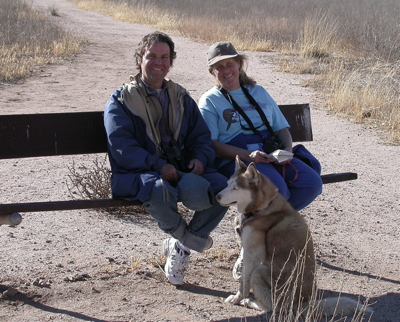
Jim and Debby Parker on Dec 29, 2002 near the San Pedro house in Sierra Vista, Arizona.
We were lucky enough to get to spend a week together tracking down so many rarities that were present in AZ that winter. Many days started out near freezing but it warmed into the low 70s and we spent every daylight hour birding. I think we eventually got all of the rarities that we knew about, plus a few more. Debby got some great photos of the fairly newly discovered Black-capped Gnatcatchers that were at Lake Patagonia that winter. It was a great trip that I will always remember!
Kelli Heindel-Levinson, Bakersfield, CA
Most areas of the U.S. have birders who eventually find each other while finding birds and form groups or clubs where they can work together to enhance their birding knowledge and lists. The Eastern Sierra is one of those areas that has many enthusiastic lovers of nature, especially birds, that banded together to share their experiences, best birding spots, resources, photographs, questions, and telephone numbers. The Eastern Sierra Audubon Society has provided programs, public field trips, Birds in the Classroom, the WAVE newsletter, and the Eastern Sierra Birds website to the community to enhance the sharing of information and stimulating these interests. All of these local resources require the energy and passion of a substantial group of people.
As in every group, there are some individuals whose contributions are extraordinary. The Eastern Sierra has such a couple, Jim and Debby Parker, and since they are leaving us we wanted to take this opportunity to remind everybody just how much they have contributed to the community, especially the avian history of Inyo County. Jim and Debby's first recorded bird sighting for Inyo County was when they found a Ross's Goose at Millpond County Park 22 March 1992 and they've come a long, long way since then. We know of no other birders, field ornithologists, or professional researchers in Inyo County who have been in the field as many hours as they have, or have written more descriptions than they have, or have prepared four seasonal reports every year as they have, or have called more people to come out and see another fancy bird they just found, or after a decade of learning spent the following decade sharing their knowledge in weekly bird field trips, or helped develop and implement the Birds in the Classroom program to get kids turned on to birds and then gathering a number of volunteers to take the kids to birding areas where they could find and identify the birds themselves, or writing bird identification articles for the WAVE, and more and more and more.
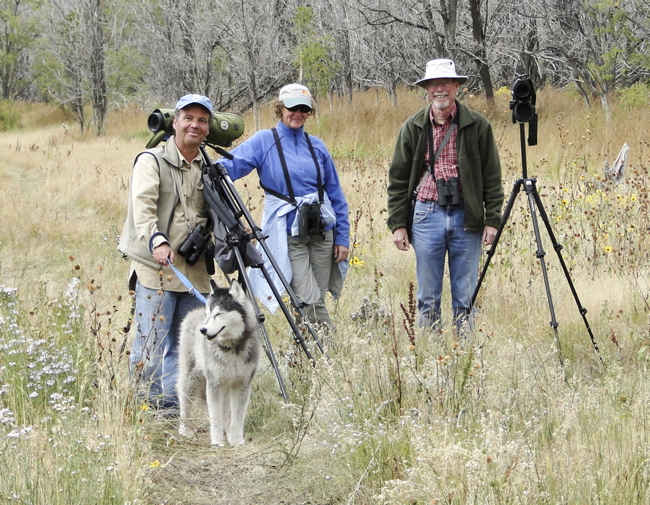
Jim with Kathy Duvall and Bill Mitchel in Round Valley. Photo by Nancy Overholtz.
The incredible sinking Debbie
We were out birding the meadow and we're walking across the wet area. Debby and I were shoulder to shoulder when suddenly she disappeared. I looked back and she is stuck in a sink hole up to her armpits. I say a big exclamation !#@%&**! that Debbie found so funny she burst out laughing. Like any true birder/photographer, she is worried about her optics. After I take all that she manages to worm her way out and is a soaking wet mess and still laughing at what I said and the look on my face.
Susan Steele
Being active birders isn't what sets them apart because there are many active birders. It's the level to which they rose in becoming reliable, thoughtful, knowledgeable, and cautious contributors to the body of avian knowledge in Inyo County. Few write as comprehensive descriptions of birds as they do with citations from the sources they accessed to answer their questions and provide them with identification information. In fact, we only know of one other person and he is a professional ornithologist! They have amassed a huge inventory of photographs/images to document their claims. Their intellectual curiosity stimulated them to try to age and sex every bird they saw, which has allowed a far more complete "calendar" of when young and adults and males and females are usually found in Inyo County. They embraced the challenge of trying to determine which subspecies they were looking at and photographing and then spend non-birding time–nighttime–studying the literature to make those determinations. Sometimes they decided there wasn't enough information for them to be sure so they didn't claim any subspecies. When the Sage Sparrow was taxonomically split into Sagebrush and Bell's Sparrow, they looked at all their images and, using the new identification tools that were provided, identified each image to its new taxon. A couple of times they made a claim, publically, and after continued study of the bird and input from others viewing the bird they changed their mind and recanted their claim, publically! It is more important to them that the truth be known than they indulge in the protect–my–reputation/ego game some birders play. Because of this character trait, others outside our Eastern Sierra group highly respect Jim and Debby and value their data as extremely reliable.
Near the beginning of their tenure in Inyo County, they expanded their backyard to include Birchim Canyon located just south of Sherwin Grade near the Mono County line. As the years accumulated, so too did the bird records from there and so too did the interest in the area by outsiders who seldom read a seasonal report in North American Birds without being reminded of the fancy birds that the Parkers had found there. It became a regular stopping spot for visitors heading north or south on Hwy 395. The data that Jim and Debby gathered in Birchim Canyon easily exceeds all other data from there gathered by everybody else…and it is data you can bank on. Any serious birder or researcher working on the birds of the Eastern Sierra needs to take a serious look at their two decades of bird data gathering that is becoming available on eBird and their data includes far more than just this special canyon.
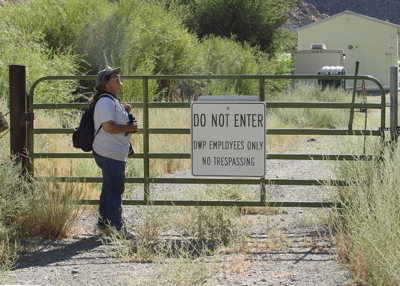
Debby at east Birchim Canyon gate. Photo by Nancy Overholtz
Debby at east Birchim Canyon gate. Photo by Nancy Overholtz
After painting my first bird, I realized I wanted to learn more about them and photograph them. So in October of 2005, Ron and I went on our first Audubon field trip with Debby around the Meadowcreek area in Bishop. I can't believe I never noticed a Spotted Towhee before but I sure did when I looked at one through binoculars for the first time. Debby is an incredible birder and teacher. Then Jim retired and we acquired another great mentor. The phrase repeated most in our life lists is "found by Jim and Debby Parker". Thanks to both of you for making our lives more meaningful.
Nancy and Ron Overholtz, Bishop, CA
The Inyo County Avian Database contains almost 400,000 entries that answer questions regarding the earliest and latest seasonal records, highest and lowest records, average daily count and maximum number of birds seen in a day, first county record, and breeding data. Considering that almost 1000 observers have supplied all the county data the average is 400 bird records per observer. The Parkers, via their seasonal reports which are ONLY their rarest species, species of special concern, unusual dates/locations/elevations of common species, and breeding data, have contributed about 5000 records to the county database. This is a small percentage of all the data they have collected!!! They compiled comprehensive lists for each day in the field with "written in the field" descriptions and photos of sightings that they recognized as being extraordinary. When in doubt, they left it out. They don't expect current reviewers to accept their raised–hands, "We had that!" claims and certainly don't expect those a century from now to rely on anything except the evidence they and other observers have left behind.
After painting my first bird, I realized I wanted to learn more about them and photograph them. So in October of 2005, Ron and I went on our first Audubon field trip with Debby around the Meadowcreek area in Bishop. I can't believe I never noticed a Spotted Towhee before but I sure did when I looked at one through binoculars for the first time. Debby is an incredible birder and teacher. Then Jim retired and we acquired another great mentor. The phrase repeated most in our life lists is "found by Jim and Debby Parker". Thanks to both of you for making our lives more meaningful.
Nancy and Ron Overholtz, Bishop, CA
The magnitude of their efforts is hard to fathom but here is a peak at some of what they have left behind:
- They added five bird species and one sub-species to the Inyo County bird list–all photographed of course:
- Trumpeter Swan 8 January–3 February 1999 at Pleasant Valley Reservoir
- Dark-eyed (White-winged) Junco 12 December 2000 southeast of Bishop was the third record of this subspecies for California
- Eurasian Collared-Dove 8 March 2002 in Bishop
- Mew Gull 8–10 May 2003 at Bishop City Park
- Eastern Wood-Pewee 22–26 October 2011in Birchim Canyon
- Great Crested Flycatcher 6 September 2012 in Birchim Canyon
- They have the second through ninth records of seven vagrants with ten or fewer county records (White-eyed Vireo, Yellow-throated Vireo, Golden-winged Warbler, Blue-winged Warbler, Yellow-throated Warbler, Canada Warbler, and Scarlet Tanager).
- They have the earliest ever spring arrival dates for 11 species (Osprey, Black Tern, Forster's Tern, Black-bellied Plover, Black-and-white Warbler, Cape May Warbler, Blackpoll Warbler, Palm Warbler, Black-throated Gray Warbler, Clay-colored Sparrow, and Grasshopper Sparrow).
- They have the latest ever spring departure dates for nine species (Greater White-fronted Goose, Whimbrel, Hammond's Flycatcher, Northern Parula, Black-throated Gray Warbler, Townsend's Warbler, Slate-colored Fox Sparrow, Baltimore Oriole, and Tricolored Blackbird).
- They have the earliest ever fall arrival dates for nine species (Greater White-fronted Goose, Black Tern, Red Knot, Red-eyed Vireo, American Redstart, Chestnut-sided Warbler, Black-throated Gray Warbler, Western Tanager, and Common Grackle.
- They have the latest ever fall records for 14 species (Osprey, Solitary Sandpiper, Calliope Hummingbird, Vaux Swift, Willow Flycatcher, Hammond's Flycatcher, Dusky Flycatcher, "Western" Flycatcher, Warbling Vireo, Black-and-white Warbler, Hermit Warbler, Tennessee Warbler, Indigo Bunting, and Common Grackle).
- They have the highest elevations for two species (Blue Grosbeak and Tricolored Blackbird).
- They have the first ever winter record for Lark Bunting.
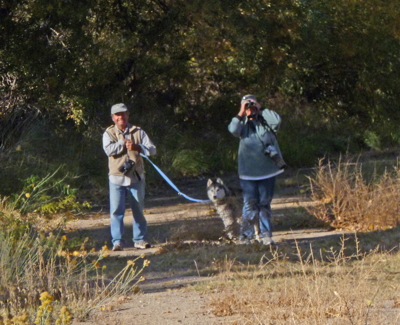
Jim and Debby (and Smokey) in Birchim Canyon
They have decided that it is time to return to Mt. Shasta in northern California to be close to family. While we regret their decision, we respect it and all that they have done for Inyo County and the birds that occur here. Their absence will be a great loss, but how fortunate are those who will benefit from the new discoveries and contributions they will make in their new home. Bon Voyage and Good Luck to Jim and Debby Parker, whose names will forever be entwined with Inyo County avian history.
One Last Story...
For over 20 years, local birders banded together to study, chase, photograph, and tick Inyo County birds. This Bird Study Group was involved in taking trips together locally, out of state, and even a few out of the country. The Parkers were important and valuable participants in many of the in and out-of-state trips and contributed to the many successes and laughs we all had while adding birds to our life and state lists.
We remember well, with broad smiles, one trip to Texas. Birders, really serious birders, get up before the sun does to grab a breakfast that will keep them going while they behave like kids running around trying to find birds. There was only one restaurant in town that opened early enough for us. The infamous Waffle House. In the pre-dawn morning we drove to the restaurant, whose lit-up sign lacked the first letter of the first word, and after eating there decided that the "new" name was appropriate. Jim greeted the group the following morning with, "we're off to the awful house!" which became the morning reveille during our stay.
At the next group meeting back in Big Pine, Jim arrived to serve his favorite awful house food, grits, while wearing a paper cap he had charmed from one of the workers at the Waffle House! Thanks for so many memories!!
Tom and Jo Heindel, Big Pine, CA
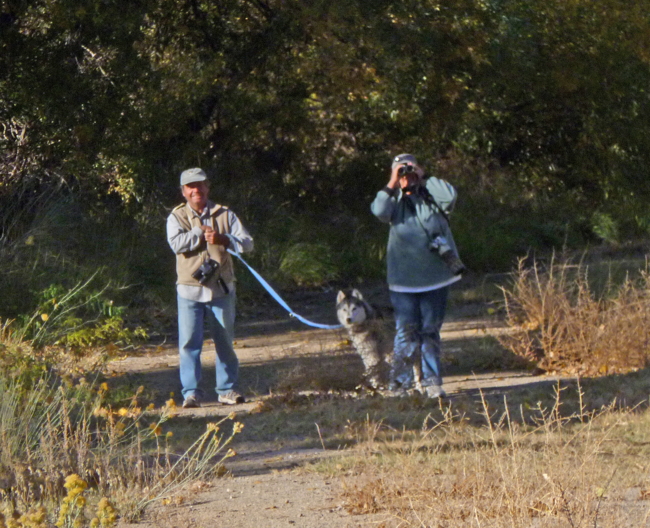
Jim and Debby in Birchim Canyon 26 Oct 2010
For over 20 years, local birders banded together to study, chase, photograph, and tick Inyo County birds. This Bird Study Group was involved in taking trips together locally, out of state, and even a few out of the country. The Parkers were important and valuable participants in many of the in and out-of-state trips and contributed to the many successes and laughs we all had while adding birds to our life and state lists.
We remember well, with broad smiles, one trip to Texas. Birders, really serious birders, get up before the sun does to grab a breakfast that will keep them going while they behave like kids running around trying to find birds. There was only one restaurant in town that opened early enough for us. The infamous Waffle House. In the pre-dawn morning we drove to the restaurant, whose lit-up sign lacked the first letter of the first word, and after eating there decided that the "new" name was appropriate. Jim greeted the group the following morning with, "we're off to the awful house!" which became the morning reveille during our stay.
At the next group meeting back in Big Pine, Jim arrived to serve his favorite awful house food, grits, while wearing a paper cap he had charmed from one of the workers at the Waffle House! Thanks for so many memories!!
Tom and Jo Heindel, Big Pine, CA
Tom and Jo Heindel have contributed a vast amount of their knowledge to the Wave Newsletter over the years (from 1993 on!). Those articles have been archived for reference, here: Heindel's articles and season highlights.
Back to Top
ESAS Needs YOU!
Hey YOU! Yeah, you, the one reading this newsletter! Would you be willing to help us out on occasion? Would you be willing to give us your email and/or phone number for those times when there is an event and we'd like to have an Eastern Sierra Audubon Table, but no board member is available? Or can we call you when we want to plan a special event that we need some help with? All of the current board have roles that keep us pretty busy, so we can't always add extra volunteering to the mix and keep any balance in our lives. But YOU could volunteer once in a while, once or twice a year or every few months, even - I'm sure you could! You would be helping us so much by doing even a little volunteer time! If you are willing, you could email us at volunteer@esaudubon.org and let us know the kind of thing you'd be interested in helping with. You don't have to be an expert birder to do a lot of this - you just need to be willing to help out on occasion. Below is a list of some things you could help out with:
- Tabling at an event (for example, Alabama Hills Day, Earth Day, Chautauqua, Banff Mountain Film Festival)
- Helping set up for programs (just come a little early and help us move chairs, and maybe stay later to help put them back)
- Leading a bird walk or field trip
- Presenting a program or workshop
- Helping out with Birds in the Classroom or other education programs
- Helping with a special event, such as the Owens Lake Bird Festival, or Mono Basin Bird Chautauqua, or an Inyo County Big Day or Christmas Bird Count
- Helping with special projects - do you have any expertise you might be able to share with us?
Sign up to be on our list of potential volunteers by emailing volunteer@esaudubon.org and letting us know what you could help with!!
Back to Top
Autumn Color
It has happened again – evidenced when the first White-crowned Sparrow was heard, and the black-tailed mule deer arrived from higher elevations – fall arrived with shifting angles of sunlight. It is absolutely exciting to witness the autumnal vegetation color change and the golden explosion throughout the Eastern Sierra as the green, food-making chlorophyll eventually ceases in production and the yellow, orange and brown (carotenoid) pigments are visible in varying, (often neon-like) hues.
Starting in higher elevations, leaf color changes occur along riparian corridors that resemble bright decorative ribbons. Aspen (Populus tremuloides) shimmer like flickering candle flames, sharply contrasting against dark-green Jeffrey pines and the pure blue sky. Rabbitbrush (Ericameria nauseosus), once the color of the sun and no longer in flower, look like tawny pom-poms dotting the landscape, and are filled with various birds and small mammals frantically foraging the seed in preparation for colder weather. Willows, wild rose, sedges and grasses – all gloriously changed and vibrant.
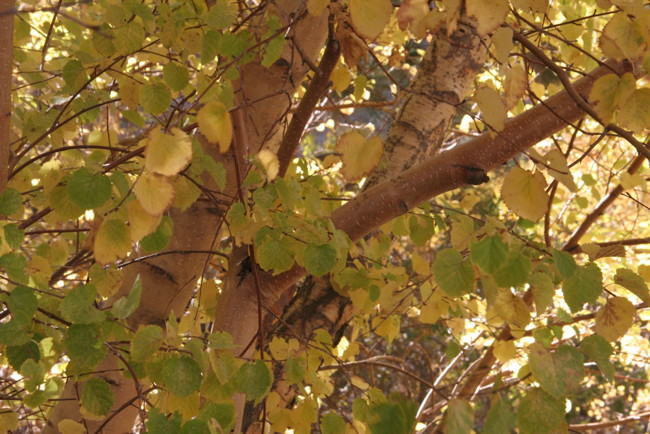
Betula occidentalis - photo by Julie Anne Hopkins
Taking a hike or a drive to see this spectacular display (highly recommended – Lower Rock Creek Road) is breathtaking, inspiring (“maybe I can finally paint!”), even overwhelming (“let me out of this car!”). The “must-see” multi-stemmed, western water birch (Betula occidentalis) with coppery-red young bark and lace-like gold-russet tiny leaves is sparkling along the streamside. Finally, descending into the valleys the huge, old cottonwoods are magnificently adorned with lemony, heart-like foliage, still hiding the raptors up high in the branches, soon to be fully exposed when the wind blows their cover away. Year after year, day after day, it is incredible. Take a deep breath and go on a color tour – it is going quickly – and then it starts over again.
Julie Anne Hopkins
Back to Top
Bird of the Month
Board Member Santiago Escruceria will be sharing a photo of a different bird each month - and all can be seen at the Bishop Paiute Tribe's COSA - join us there on the second Saturday of each month to see these birds and more! See upcoming field trips here.
Bushtit
The Bushtit is a small bird with a long tail and a short stubby bill. It has an overall gray-brown body. Sometimes it has a somewhat darker gray or brown crown. It likes to chatter constantly in high-pitched notes. They hang around in large flocks, but are sometimes hard to see because they move swiftly through dense foliage. Seen at COSA reserve, fairly common in riparian woodlands and bushy habitat.
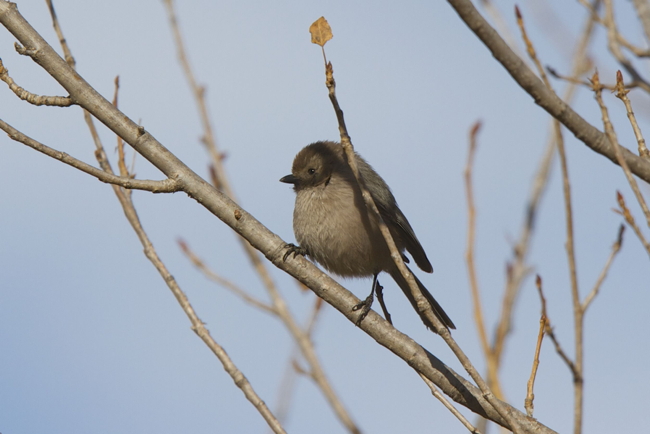
Bushtit - photo by Santiago Escruceria
Sources:
- The Sibley Guide To Birds. Second Edition, 2014. Written and illustrated by David Allen Sibley.
- The Stokes Field Guide To The Birds Of North America. First Edition, 2010. Donald and Lillian Stokes.
- Birds Of The Sierra Nevada, Their Natural History, Status, And Distribution. 2013. Edward C. Beedy and Edward R. Pandolfino; Illustrated by Keith Hansen
Back to Top
Inyo National Forest Plan
Inyo National Forest Plan
Don’t miss the opportunity to provide comments and concerns
Next public meeting for Inyo National Forest: 6:00-8:00pm - Thursday, November 20
Tri-County Fairgrounds, Tallman Pavilion, Sierra Street & Fair Drive, Bishop, CA
These “open house” styled meetings are primarily informational to share the issues and concerns the agency heard during the recently completed scoping phase. The meetings are an opportunity for the public to hear discussion how those issues and concerns are being used to frame a preliminary range of alternatives. There is no formal comment period associated with these meetings. As always, the Forest Service welcomes opportunities for thoughtful dialogue.
In September, the Forest Service announced its intent to develop an environmental impact statement (EIS) that, when completed, will revise forest plans for the Inyo, Sequoia, and Sierra National Forests.
The Sierra, Sequoia and Inyo are three of eight national forests that were selected as “early adopters,” meaning they will be the first forests to revise their land management plans using the new 2012 National Forest System Planning Rule. The planning rule provides the framework for Forest Service land management plans across the nation.
The final EIS will result in three separate plans with three Records of Decision following the revised forest plans. Forest Supervisors will remain the “responsible official” for making decisions on their specific forest plans.
There will be an opportunity for formal comment when the draft EIS (DEIS) is released. The Forest Service expects to publish a “Notice of Availability of DEIS” in April 2015, which begins a 90-day public comment period.
For more information and to review the planning documents go to: www.fs.usda.gov/main/r5/landmanagement/planning
Return to Top
REGION 5 FOREST PLAN REVISIONS UPDATE: SCOPING COMMENTS RELEASED -- TALKING POINTS (10/30/14):
- On August 29, 2014, the Pacific Southwest Region (Region 5) of the Forest Service published a Notice of Intent and Proposed Action to revise land management plans (forest plans) for the Inyo, Sequoia and Sierra National Forests in the Federal Register.
- These three Region 5 forests are revising their forest plans under the 2012 Forest Service Planning Rule.
- The 2012 Planning Rule requires public and cooperating agency collaboration throughout the forest planning process.
- Public involvement, interagency collaboration, and transparency are key components of the 2012 planning rule.
- Publishing the Notice of Intent in the Federal Register initiated a 30-day scoping comment period to provide the public an opportunity to review the Proposed Action and to provide comments on the proposal.
- Region 5 received approximately 7,200 public comments in response to the forest plan revision Notice of Intent and Proposed Action.
- In addition to the 7,200 scoping comments that Region 5 received, public involvement was enhanced by public and tribal forums and workshops, formal tribal consultation meetings, and Forest Service employee feedback.
- As published in the August 29, 2014, Federal Register, and described in the “Notice of Intent,” scoping comments received by the Forest Service, including names and addresses of those who comment, becomes part of the public record for the proposed action of the forest plan revisions.
Individual comments can be reviewed online at https://cara.ecosystem-management.org/Public//ReadingRoom?Project=3375
- The Inyo, Sequoia, and Sierra national forests have scheduled three “open house” styled meetings during the week of November 17-20, 2014.
- During these informational public meetings, the Forest Service will share issues and concerns it received during the recently completed scoping period and how they were used to frame a preliminary range of alternatives.
- There is no formal comment period associated with the November public meetings, but an opportunity for a thoughtful dialog with agency regional and forest planning specialists.
- Region 5 is considering feedback it received from these efforts as draft environmental impact statement (EIS) alternatives for the forest plan revisions are developed.
- There will be another formal comment period when the draft EIS is released and posted to the Region’s forest plan revision website found at http://tinyurl.com/r5earlyadopters.
Return to Top
Reports
Fall Field Trip Reports:
Inyo Craters Fall Forest Migrant Field Trip, September 16
Leader: Santiago Escruceria
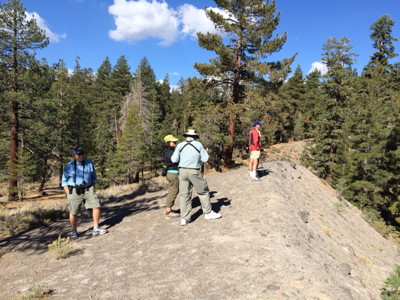
Birding on the rim of one of the Inyo Craters
Eighteen birders enjoyed this gentle walk through pine forest, ending at the Inyo Craters to look for fall migrants. It was a beautiful day, as you can see from the photo at right.
Birds spotted by the group included the following: Cooper's Hawk, Red-tailed Hawk, Band-tailed Pigeon, Lewis' Woodpecker, Hairy Woodpecker, Hammond's/Dusky Flycatcher, Steller's Jay, Clark's Nutcracker, Common Raven, Mountain Chickadee, Red-breasted Nuthatch, White-breasted Nuthatch, Brown Creeper, Hermit Thrush, Yellow-rumped Warbler, Dark-eyed Junco, and Cassin's Finch.
Sierra Club Inyo Craters Birding, September 13
The Sierra Club Range of Light Group also had a birding trip to Inyo Craters just a few days earlier on 9/13, led by Ken Wells and Karen Murphy. Jane Kenyon sent this descriptive report of their trip:
A good day for 8 participants, actively noticing the species of birds out at the Inyo Craters phreatic explosion pits. We listened to the Red-breasted and White-breasted Nuthatch throughout the forest up to the Crater. Then saw the Chipping Sparrows soaring down into the Crater. The 2nd Crater with more resident birds, including the Red Crossbills, had a small flock of Band-tailed Pigeons from the westside. Along Deadman Creek was the Yellow-rumped Warbler, the short-distance migrant of the Sierra, with Mountain Chickadees and other resident birds. The Dragonflies gave a great aerial display of their acrobatic flying along the creek.
The birdwalk ended with the great surprise to see the Black-backed Woodpecker, specific to burned forests. Total species seen by everyone for the day were 23.
We will hope to have more field trips to the Inyo Craters in the future!
Mono Lake County Park, September 23, Leader: Santiago Escruceria
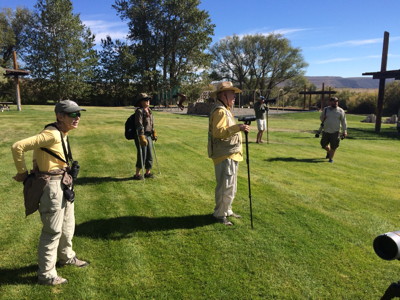
Birders at Mono Lake County Park
Six birders enjoyed this accessible bird walk at the northwestern shore of Mono Lake, where participants explored different habitats, including riparian, open field (grass and sage), and Mono Lake’s shoreline. Always a lovely place to bird.
Birds observed included: Mallard, Northern Shoveler, Green-winged Teal, California Quail, Eared Grebe, Cooper's Hawk, Red-shouldered Hawk – A very vocal accipiter, with a long tail, long-legged and short wings. Rusty shoulder patch, same on the body and underwing. Bird seen before in this area on 2013-09-13. Red-tailed Hawk, Killdeer, American Avocet, Western Sandpiper, Red-necked Phalarope, California Gull, Red-breasted Sapsucker, Hairy Woodpecker, Northern Flicker (Red-shafted), Cassin's Vireo, Black-billed Magpie, Clark's Nutcracker, Common Raven, Bewick's Wren, American Robin, Orange-crowned Warbler, Yellow-rumped Warbler, Spotted Towhee, Savannah Sparrow, White-crowned Sparrow, Western Meadowlark, and Brewer's Blackbird.
Watch for future field trips on our website's Field Trips page!
Return to Top
Birdseed Prices in Bishop
With winter soon upon us, many of us will be thinking about feeding our fine feathered friends. What are the prices of seed in Bishop and where do you find them? With those questions in mind, I called six local businesses who carry birdseed. I asked each one if they would consent to sharing their prices in our newsletter and they all heartily wished to participate. The six businesses include, in alphabetical order, Bishop Nursery, Chalfant BigTrees, High Country Lumber, Manor True Value Hardware, Sierra Saddlery/Allen's Hardware (Red Horse), and Wye Road Feed and Supply. The four products compared are Nyjer Thistle Seed, Black Oil Sunflower Seed, Wild Birdseed mix with Sunflower, and Dove and Quail Mix. The lowest price by pound in each category is in bold print.
Do keep in mind that quality of seed can vary greatly. There are Econo mixes, Premium mixes, and Deluxe mixes. I did not research the differences. I tried in all cases to print prices of what I thought were comparable products according to the verbal descriptions given by the business' proprietors. Buy Local!
Rosie Howard
Birdseed Prices in Bishop
| Seed Type |
Price per bag |
Price per pound (by bag size) |
| Nyjer |
50 lbs |
25 lbs |
20 lbs |
8 lbs |
|
50 |
25 |
20 |
8 |
|
| Bishop Nursery |
$65.00 |
$34.42 |
$28.15 |
|
|
$1.30 |
$1.38 |
$1.41 |
|
|
| Chalfant Big Trees |
|
$29.85 |
|
|
|
|
$1.19 |
|
|
|
| High Country Lumber |
|
|
|
$17.99 |
|
|
|
|
$2.25 |
|
| Manor True Value |
|
|
$29.99 |
|
|
|
|
$1.50 |
|
|
| Red Horse |
|
$39.95 |
|
|
|
|
$1.60 |
|
|
|
| Wye Road Feed |
$75.95 |
$45.99 |
|
|
|
$1.52 |
$1.84 |
|
|
|
| |
|
|
|
|
|
|
|
|
|
|
| Black Oiled Sunflower Seed |
50 lbs |
40 lbs |
25 lbs |
20 lbs |
5 lbs |
50 |
40 |
25 |
20 |
5 |
| Bishop Nursery |
|
$30.26 |
|
$16.38 |
|
|
$0.76 |
|
$0.82 |
|
| Chalfant Big Trees |
$29.95 |
|
$18.00 |
|
|
$0.60 |
|
$0.72 |
|
|
| High Country Lumber |
|
|
|
$15.99 |
|
|
|
|
$0.80 |
|
| Manor True Value |
|
$26.99 |
|
$18.99 |
|
|
$0.67 |
|
$0.95 |
|
| Red Horse |
$39.99 |
|
|
|
|
$0.80 |
|
|
|
|
| Wye Road Feed |
$46.40 |
|
|
|
$7.40 |
$0.93 |
|
|
|
$1.48 |
| |
|
|
|
|
|
|
|
|
|
|
| Wild Bird Mix with Sunflower Seeds |
50 lbs |
40 lbs |
25 lbs |
20 lbs |
|
50 |
40 |
25 |
20 |
|
| Bishop Nursery |
|
$28.90 |
|
$15.64 |
|
|
$0.72 |
|
$0.78 |
|
| Chalfant Big Trees |
$20.50 |
|
|
|
|
$0.41 |
|
|
|
|
| High Country Lumber |
|
$28.90 |
|
$15.64 |
|
|
$0.72 |
|
$0.78 |
|
| Manor True Value |
|
|
|
$11.99 |
|
|
|
|
$0.60 |
|
| Red Horse |
|
$30.99 |
|
$16.99 |
|
|
$0.77 |
|
$0.85 |
|
| Wye Road Feed* |
$19.75 |
|
|
|
|
$0.40 |
|
|
|
|
| *Econo Mix |
|
|
|
|
|
|
|
|
|
|
| |
|
|
|
|
|
|
|
|
|
|
| Dove and Quail Food |
40 lbs |
25 lbs |
20 lbs |
|
|
40 |
25 |
20 |
|
|
| Bishop Nursery |
$33.66 |
|
$18.22 |
|
|
$0.84 |
|
$0.91 |
|
|
| Chalfant Big Trees |
$21.00 |
|
|
|
|
$0.53 |
|
|
|
|
| High Country Lumber |
(special order only) |
|
|
|
|
|
|
|
|
|
| Manor True Value |
(does not carry) |
|
|
|
|
|
|
|
|
|
| Red Horse |
$31.99 |
|
$16.99 |
|
|
$0.80 |
|
$0.85 |
|
|
| Wye Road Feed |
|
$22.50 |
|
|
|
|
$0.90 |
|
|
|
| Seed Type |
Price per bag |
Price per pound |
| Nyjer |
50 lbs |
25 lbs |
20 lbs |
8 lbs |
|
50 |
25 |
20 |
8 |
|
| Bishop Nursery |
$65.00 |
$34.42 |
$28.15 |
|
|
$1.30 |
$1.38 |
$1.41 |
|
|
| Chalfant Big Trees |
|
$29.85 |
|
|
|
|
$1.19 |
|
|
|
| High Country Lumber |
|
|
|
$17.99 |
|
|
|
|
$2.25 |
|
| Manor True Value |
|
|
$29.99 |
|
|
|
|
$1.50 |
|
|
| Red Horse |
|
$39.95 |
|
|
|
|
$1.60 |
|
|
|
| Wye Road Feed |
$75.95 |
$45.99 |
|
|
|
$1.52 |
$1.84 |
|
|
|
| |
|
|
|
|
|
|
|
|
|
|
| Black Oiled Sunflower Seed |
50 lbs |
40 lbs |
25 lbs |
20 lbs |
5 lbs |
50 |
40 |
25 |
20 |
5 |
| Bishop Nursery |
|
$30.26 |
|
$16.38 |
|
|
$0.76 |
|
$0.82 |
|
| Chalfant Big Trees |
$29.95 |
|
$18.00 |
|
|
$0.60 |
|
$0.72 |
|
|
| High Country Lumber |
|
|
|
$15.99 |
|
|
|
|
$0.80 |
|
| Manor True Value |
|
$26.99 |
|
$18.99 |
|
|
$0.67 |
|
$0.95 |
|
| Red Horse |
$39.99 |
|
|
|
|
$0.80 |
|
|
|
|
| Wye Road Feed |
$46.40 |
|
|
|
$7.40 |
$0.93 |
|
|
|
$1.48 |
| |
|
|
|
|
|
|
|
|
|
|
| Wild Bird Mix with Sunflower Seeds |
50 lbs |
40 lbs |
25 lbs |
20 lbs |
|
50 |
40 |
25 |
20 |
|
| Bishop Nursery |
|
$28.90 |
|
$15.64 |
|
|
$0.72 |
|
$0.78 |
|
| Chalfant Big Trees |
$20.50 |
|
|
|
|
$0.41 |
|
|
|
|
| High Country Lumber |
|
$28.90 |
|
$15.64 |
|
|
$0.72 |
|
$0.78 |
|
| Manor True Value |
|
|
|
$11.99 |
|
|
|
|
$0.60 |
|
| Red Horse |
|
$30.99 |
|
$16.99 |
|
|
$0.77 |
|
$0.85 |
|
| Wye Road Feed* |
$19.75 |
|
|
|
|
$0.40 |
|
|
|
|
| *Econo Mix |
|
|
|
|
|
|
|
|
|
|
Keep in mind, also, that several of these stores have regular sales on seed - now you have something to compare them to! Thanks Rosie! – Ed.
Back to Top
It’s Time to Start Thinking About the New Audubon T-Shirts!
We have the “New Logo T-Shirts” in at Spellbinder in fun new colors and styles! It’s never too early to start your Christmas shopping.
I went wild with the T-shirt order this time as I was hoping to get through the winter without having to do another order, so there are LOTS of T’s to choose from: short-sleeved, long-sleeved, men’s , women’s , ribbed, cuffed and not, in sizes from small to XXL. Most are the full-color design, but we have a few white designs for those who want a different take on our new logo. There are even a few of the original design left for only $15.00 – sizes small and medium only.
Colors: Turquoise, royal blue, plum, dark green, light green, Texas orange, and, new this time for those who want to work out in style, a light grey cotton/poly blend. Also, colors from the last order are still around!
These shirt sales help us fund our graduating senior scholarship which are given to two young people who will support the ideals of Audubon in their future endeavors.
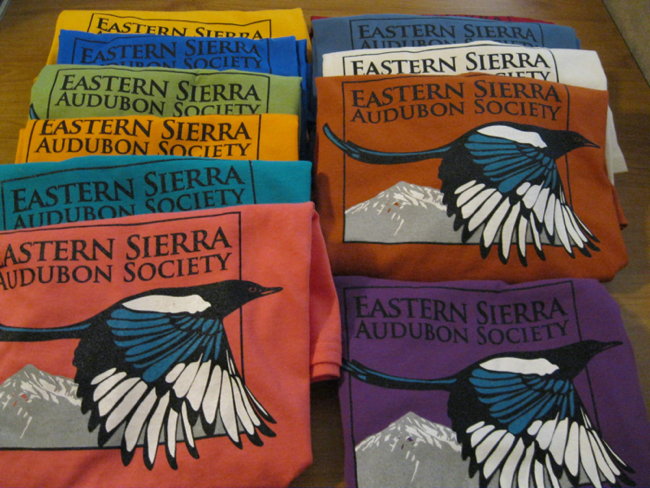
Look at all those great colors!
P.S. While you are there, buy a book or two at Spellbinder who have been nice enough to give us shelf space to sell our shirts!
Roberta Lagomarsini
Back to Top
Taking Care of Business
Welcome New and Rejoining Members!
Eastern Sierra Audubon would like to thank the following new members for their support:
- Fran Hunt
- Coco Sly
- Vickie Taton
Thank you, also, to the members who recently renewed their memberships - your ongoing support keeps our chapter alive.
A Note from our new Membership Chair, Ann Hoffmann:
Greetings Everyone!
As Membership Chair, I mailed out thirty-one renewal notices this past September. We received many responses to continue membership in the local chapter of Eastern Sierra Audubon. Everyone who responded shared a kind comment. Whether a member lives in Mammoth Lakes, Big Pine, Bishop, Swall Meadows, Benton, Berkeley, Ventura, San Mateo, Valley Center, Santa Rosa, Lee Vining, Santa Ana, Quartz Hill, June Lake, Las Vegas, or Santa Cruz, we are all on the same mission of being out of doors and loving to see, study, and marvel at birds, not only in our own community, but in the world.
Most recently, the dues which you all so kindly gave, supported the chapter’s purchase of a projector which can be used by program presenters. The chapter also purchased much-needed new binoculars which are being put to good use by students and adults at our various educational programs and field trips. Eastern Sierra Audubon also presents graduating high school seniors in Inyo and Mono Counties with scholarships.
On behalf of all the board members of Eastern Sierra Audubon, please accept a sincere “Thank You.” And on a personal note, I enjoyed hearing from you all and I hope you could read my handwriting!
Ann Hoffmann
Membership Chair, Eastern Sierra Audubon
If you would like to join or renew and help support Eastern Sierra Audubon, there are two ways you can do it:
- Join as a National Audubon Society Member, designating ESAS as your chapter affiliation (your zip code will associate you with the chapter nearest you). Includes Audubon Magazine subscription. This is $20 for the first year, and goes up to $35 annually thereafter.
- Join as an ESAS Chapter-only Member for $20 per year. 100% of your donation stays here in the Eastern Sierra this way. Your chapter membership is a way to give back, and show your appreciation for all that ESAS does, and to help support our mission locally. Your membership helps pay for scholarships, programs, special events, education programs, research, and more. THANK YOU for your support!
Click Here for a membership form to join or renew, or pick up a membership form and join at any Audubon event!
Back to Top
How You Can Help ESAS: Four R’s (and a V)
Renew your membership (or join): The money from your membership dues is what helps us bring great evening programs, special events, - educational programs, trips, this website, and more to the community - we need your support!
Recycle at Manor Market and tell them to donate the money to Eastern Sierra Audubon.
Respect property and get permission to bird on private or restricted access property.
Repeat: Spread the word about programs and events, encourage others to join and participate.
Volunteer: Come to a board meeting and consider volunteering for an open board position! We welcome new board members, and we also always need volunteers for Birds in the Classroom, participants in bird counts, Bird-A-Thons, etc.
Message from the Editor
Our next newsletter deadline will be December 15th for the
January-February issue, and of course you are always welcome to send submissions for future newsletters
and also the monthly email at any time.
We send out about one email each month to remind you of upcoming events - if you are not
on our email list, please
add yourself so you don’t miss anything!
If you send items to the newsletter
editor by the last week of any month, we’ll make sure they get included in
the next issue.
All of our content is supplied by our awesome members... if you have any ideas about articles you’d like to see, or better yet, if you have anything to share for newsletter publication, whether an article, a news item, update, correction, poem, essay, artwork, photo, field trip report, neat birding experience, letter, etc, please send it, along with any comments or suggestions, to the newsletter
editor. We’d love to hear from you!
You may send items for inclusion in the newsletter at any time, but please
send any timely items to arrive before the first of the month, so they can
be included in the monthly email update.
Thanks for reading, and happy birding!
Maggie Riley, Newsletter Editor
Back to Top
Calendar for November-December
Back to Top
Final Shot
Produced by Susan and Dan Gottlieb. Featuring Andrea Jones, Mike Prather, Peter Pumphrey and Bill Van Wagoner. Co-directed by Ed Gutentag and Erik Friedl. Local wildlife filmed by Erik Friedl. Photo credits: Mike Prather, Andrea Jones/National Audubon Society, Ali Sheehy, William T. Reed, Charles W. Hull, Richard Ellis, Bill Bouton, LADWP, NASA.
Back to Top





















